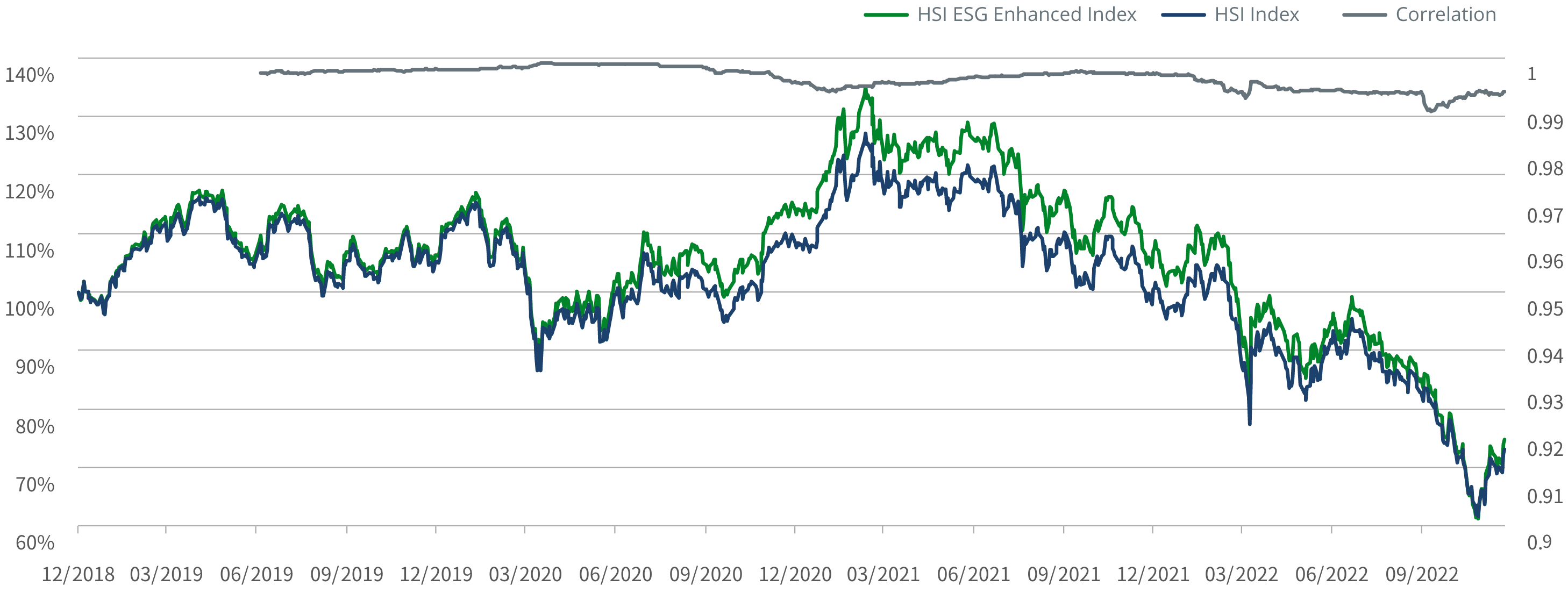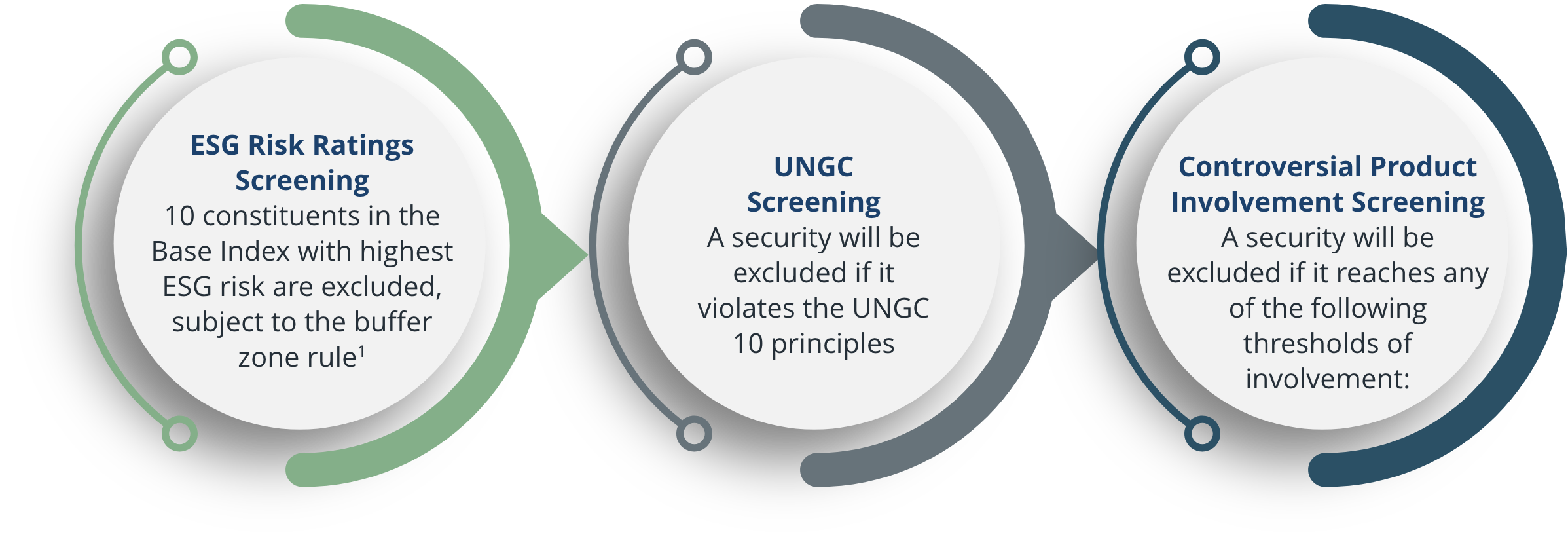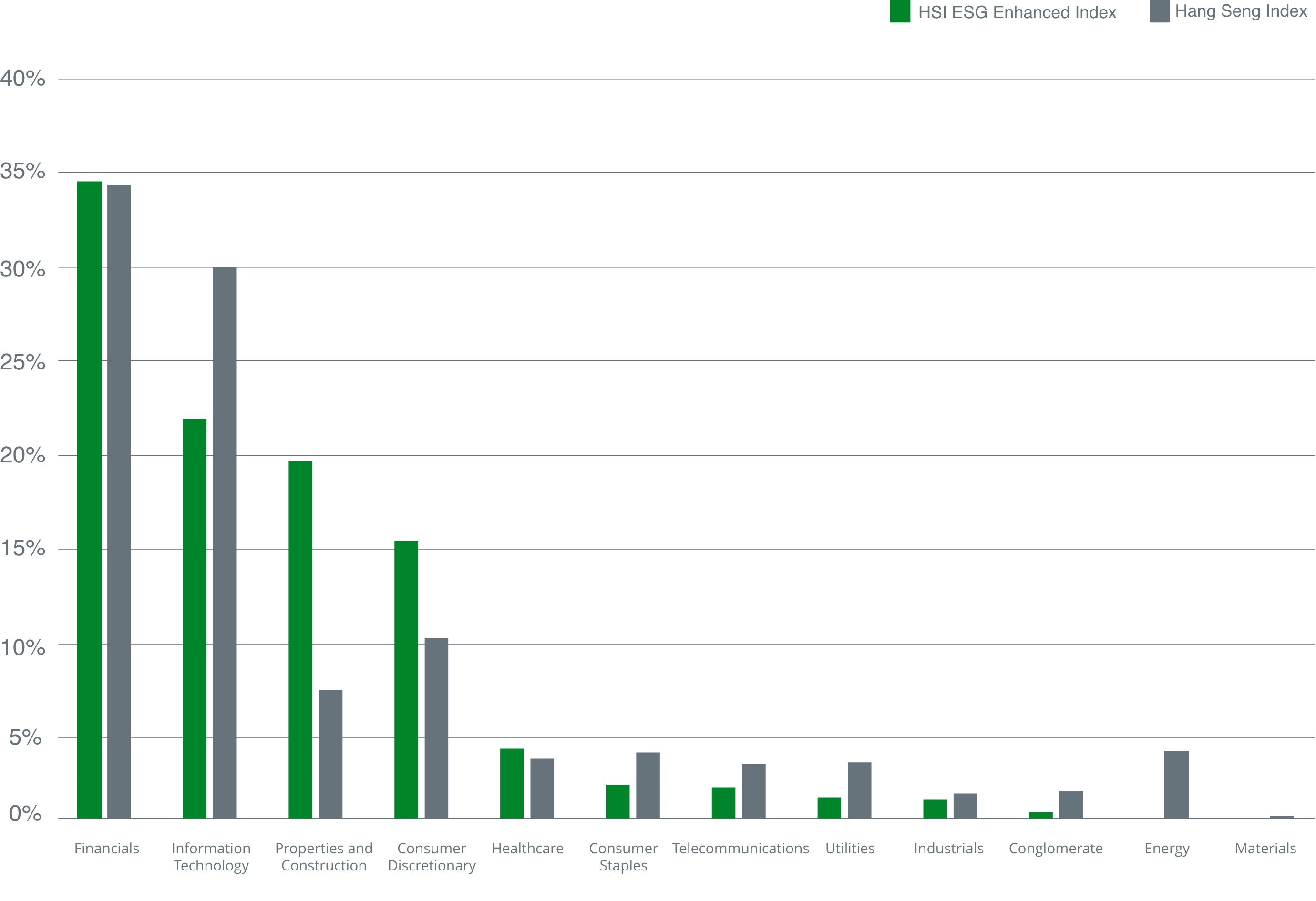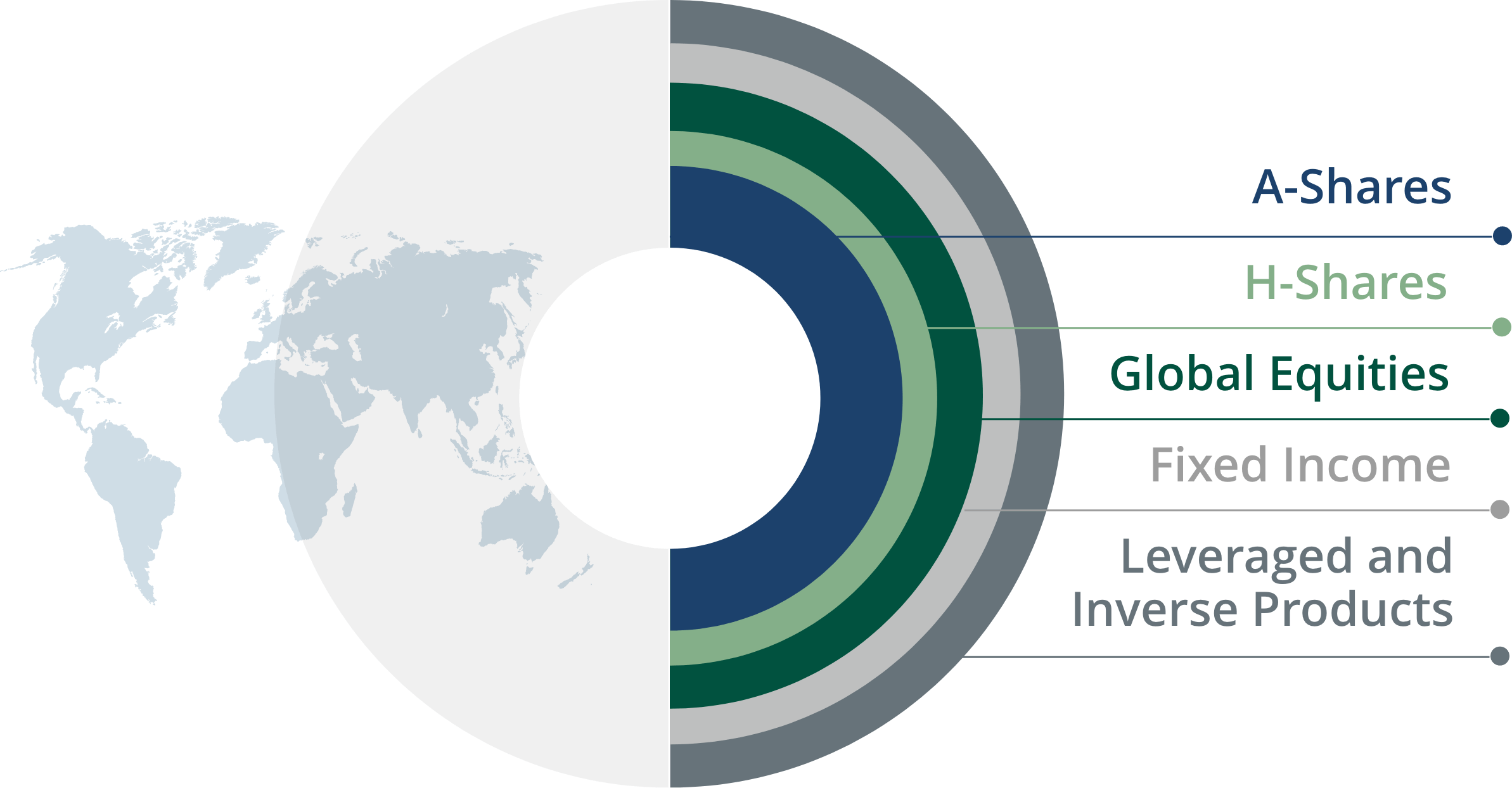Product Risk Warning
Investment involves risks, including the loss of principle. Past performance is not indicative of future results. Before investing in below products, investor should refer to the Fund's prospectus for details, including the risk factors. You should not make investment decision based on the information on this material alone. Please note:
Important Information about ChinaAMC HSI ESG ETF
- The Fund aims to provide investment result that, before fees and expenses, closely corresponds to the performance of the HSI ESG Enhanced Index (the "Index").
- The Fund is passively managed. Falls in the Index are expected to result in corresponding falls in the value of the Fund.
- The Fund's investment in equity securities is subject to general market risks, whose value may fluctuate due to various factors.
- The Index is a new index. The Fund may be riskier than those tracking more established indices with longer operating history.
- The Fund is subject to concentration risks in a single geographical region (Greater China). The Fund may be more volatile than a broadly-based fund.
- The Fund is subject to risks associated with ESG investing, such as investment performance affected by ESG exclusion criteria, ESG concentration, incomplete and inaccurate ESG data and assessment, lack of standardized ESG taxonomy, etc.
- The Fund is subject to securities lending transactions risks, including the risk that the borrower may fail to return the securities in a timely manner.
- Generally, retail investors can only buy or sell units of the Fund on the SEHK, of which the trading price is driven by market factors such as the demand and supply of the units. Therefore, the units may trade at a substantial premium or discount to the Fund's NAV.
- The Fund is subject to tracking error risk.
- If any suspension of the inter-counter transfer of units and/or any limitation on the level of services by brokers and CCASS participants occurs, unitholders will only be able to trade their units in one counter. The market price of units traded in each counter may deviate significantly.
- Unitholders will receive distributions in the HKD only. Unitholder without HKD account may have to bear the fees and charges associated with currency conversion.
- The Fund may at its discretion pay distribution out of capital or effectively out of capital. Payment of dividends out of capital or effectively out of capital amounts to a return or withdrawal of part of an investor's original investment or from any capital gains attributable to that original investment. Any distributions may result in an immediate reduction in the NAV per Unit of the Fund.
Important Information about ChinaAMC CSI 300 Index ETF
- The Fund aims to provide investment result that, before fees and expenses, closely corresponds to the performance of the CSI 300 Index (the "Index"). The Fund invests in the PRC's securities market through the Manager's RQFII status and the Stock Connect.
- The Fund is subject to concentration risk as a result of tracking the performance of a single geographical region (the PRC) and may likely be more volatile than a broad-based fund.
- The Fund is subject to risks relating to the RQFII regime, such as change of rules and regulations, default in execution or settlement of transaction by a PRC broker or the PRC Custodian and repatriation restrictions.
- The Fund is subject to risks associated with the Stock Connect, such as change of relevant rules and regulations, quota limitations, suspension of the Stock Connect programme.
- Investing in the PRC, involve greater political, tax, economic, foreign exchange, liquidity, legal and regulatory risks.
- If there is a suspension of the inter-counter transfer of units between counters, the unitholders will only be able to trade their units in the relevant counter on the SEHK. The market price on the SEHK of units traded in different counters may deviate significantly due to different factors, as such investors may pay more or receive less when buying units traded in HKD on the SEHK than in respect of units traded in RMB and vice versa.
- As the SSE and the SZSE may be open when units in the Fund are not priced, the value of the securities in Fund's portfolio may change on days when investors will not be able to purchase or sell the Fund's units. Differences in trading hours between the SSE and the SZSE, and the SEHK and A-Shares' trading bands may increase the level of premium/discount of the unit price to its NAV.
- The Fund is denominated in RMB. RMB is currently not freely convertible and is subject to exchange controls and restrictions. A non-RMB based investors in units are exposed to foreign exchange risk.
- The Fund is subject to securities lending transactions risks, including the risk that the borrower may fail to return the securities in a timely manner.
- Payment of dividends out of capital or effectively out of capital amounts to a return or withdrawal of part of an investor's original investment or from any capital gains attributable to that original investment. Any distributions may result in an immediate reduction in the NAV per Unit of the Fund.
- The Fund is subject to tracking error risk.
- The Fund is not "actively managed" and therefore, when there is a decline in the Index, the Fund will also decrease in value.
- Generally, retail investors can only buy or sell units of the Fund on the SEHK. The trading price of the units on the SEHK is driven by market factors such as the demand and supply of the units. Therefore, the units may trade at a substantial premium or discount to the Fund's NAV.
Important Information about ChinaAMC MSCI China A 50 Connect ETF
- The Fund aims to provide investment result that, before fees and expenses, closely corresponds to the performance of the MSCI China A 50 Connect Index (the "Index").
- The Fund is passively managed. Falls in the Index are expected to result in corresponding falls in the value of the Fund.
- The Fund's investment in equity securities is subject to general market risks, whose value may fluctuate due to various factors.
- The Index is a new index. The Fund may be riskier than those tracking more established indices with longer operating history.
- The Fund is subject to concentration risks in a single geographical region (Mainland China). The Fund may be more volatile than a broadly-based fund.
- The Fund is subject to risks associated with the Stock Connect, such as change of relevant rules and regulations, quota limitations, suspension of the Stock Connect programme.
- The Fund is subject to securities lending transactions risks, including the risk that the borrower may fail to return the securities in a timely manner.
- The Fund is denominated in RMB. RMB is currently not freely convertible and is subject to exchange controls and restrictions. Non-RMB based investors in units are exposed to foreign exchange risk.
- As the SSE and the SZSE may be open when units in the Fund are not priced, the value of the securities in Fund's portfolio may change on days when investors will not be able to purchase or sell the Fund's units. Differences in trading hours between the SSE, the SZSE and the SEHK, and A-Shares' trading bands may increase the level of premium/discount of the unit price to its NAV.
- Generally, retail investors can only buy or sell units of the Fund on the SEHK, of which the trading price is driven by market factors such as the demand and supply of the units. Therefore, the units may trade at a substantial premium or discount to the Fund's NAV.
- The Fund is subject to tracking error risk.
- If any suspension of the inter-counter transfer of units and/or any limitation on the level of services by brokers and CCASS participants occurs, unitholders will only be able to trade their units in one counter. The market price of units traded in each counter may deviate significantly.
- Unitholders will receive distributions in the RMB only. Unitholder without RMB account may have to bear the fees and charges associated with currency conversion.
- The Fund may at its discretion pay distribution out of capital or effectively out of capital. Payment of dividends out of capital or effectively out of capital amounts to a return or withdrawal of part of an investor's original investment or from any capital gains attributable to that original investment. Any distributions may result in an immediate reduction in the NAV per Unit of the Fund.
Important Information about ChinaAMC Hang Seng Hong Kong Biotech Index ETF
- The Fund aims to provide investment result that, before fees and expenses, closely corresponds to the performance of the Hang Seng Hong Kong-Listed Biotech Index (the "Index").
- The Fund is passively managed. Falls in the Index are expected to result in corresponding falls in the value of the Fund.
- The Fund's investment in equity securities is subject to general market risks, whose value may fluctuate due to various factors.
- The Index is a new index. The Fund may be riskier than those tracking more established indices with longer operating history.
- The Fund is subject to concentration risks in biotech companies and in a particular geographical region (i.e. Hong Kong and mainland China). The Fund may be more volatile than a broadly-based fund.
- The Fund is exposed to risks associated with characters of biotech companies, such as pre-revenue, incurrence of net current liabilities, lower liquidity, higher volatility, dependency on intellectual property rights or patents, technological changes, increased regulations and intense competition.
- The Fund is subject to securities lending transactions risks, including the risk that the borrower may fail to return the securities in a timely manner.
- The Fund is subject to tracking error risk.
- If any suspension of the inter-counter transfer of units and/or any limitation on the level of services by brokers and CCASS participants occurs, unitholders will only be able to trade their units in one counter. The market price of units traded in each counter may deviate significantly.
- Unitholders will receive distributions in the HKD only. Non HKD based unitholder may have to bear bank or financial institution fees and charges associated with currency conversion.
- The Fund's base currency is HKD but has units traded in USD. Investors may be subject to additional costs or losses associated with foreign currency fluctuations.
- Generally, retail investors can only buy or sell units of the Fund on the SEHK. The trading price of the units on the SEHK is driven by market factors such as the demand and supply of the units. Therefore, the units may trade at a substantial premium or discount to the Fund's NAV.
Important Information about ChinaAMC Hang Seng TECH Index ETF
- The Fund aims to provide investment result that, before fees and expenses, closely corresponds to the performance of the Hang Seng TECH Index (the "Index").
- The Fund is passively managed and the Manager will not have the discretion to adapt to market changes. Falls in the Index are expected to result in corresponding falls in the value of the Fund.
- The Fund's investment in equity securities is subject to general market risks, whose value may fluctuate due to various factors.
- The Index is a new index. The Fund may be riskier than those tracking more established indices with longer operating history.
- The Fund is subject to concentration risks in companies with technology theme and in a single geographical region (i.e. Greater China). The Fund may be more volatile than a broadly-based fund.
- Companies in the technology sector are characterised by relatively higher volatility in price performance when compared to other sectors.
- The Fund may be exposed to risks associated with different technology sectors and themes. A downturn in the business for companies in these sectors or themes may have adverse effects on the Fund.
- The Fund is subject to tracking error risk, which may result from the investment strategy used, and fees and expenses.
- If there is a suspension of the inter-counter transfer of units and/or any limitation on the level of services by brokers and CCASS participants, Unitholders will only be able to trade their units in one counter, which may inhibit or delay an investor dealing. The market price of units traded in each counter may deviate significantly.
- Generally, retail investors can only buy or sell units of the Fund on the SEHK. The trading price of the units on the SEHK is driven by market factors such as the demand and supply of the units. Therefore, the units may trade at a substantial premium or discount to the Fund's NAV.
Important Information about ChinaAMC NASDAQ 100 ETF
- The Fund aims to provide investment results that, before fees and expenses, closely correspond to the performance of the NASDAQ-100 Index. The Fund concentrates its investment in securities listed on the NASDAQ Stock Market and is subject to concentration risk as a result of tracking the performance of markets in a single country (the US) and securities listed on a single exchange (the NASDAQ Stock Market). It is likely to be more volatile than a broad-based fund as it is more susceptible to fluctuations in value resulting from adverse conditions in the US. The value of securities in the Fund's portfolio may change on days when investors will not be able to purchase or sell units of the Fund as the NASDAQ Stock Market will be open when units of the Fund are not priced.
- The units of the Fund may trade at a substantial premium or discount to their NAV.
- The Fund is subject to tracking error risks due to factors such as fees and expenses and the representative sampling strategy that may be adopted by the Manager.
- The Fund's Base Currency is in HKD but has units traded in USD (in addition to HKD). Investors may be subject to additional costs or losses associated with foreign currency fluctuations between the Base Currency and the USD trading currency when trading units in the secondary market.
- If there is a suspension of the inter-counter transfer of units between the counters and/or any limitation on the level of services provided by brokers and CCASS participants, unitholders will only be able to trade their units in one counter, which may inhibit or delay an investor dealing.
- The market price of units traded in each counter may deviate significantly due to different factors such as market liquidity, market supply and demand in each counter and the exchange rate fluctuations between HKD and USD.
Important Information about ChinaAMC MSCI Japan Hedged to USD ETF
- The Fund aims to provide investment results that, before fees and expenses, closely correspond to the performance of the MSCI Japan 100% Hedged to USD Index.
- The Fund concentrates its investment in Japanese securities and is subject to concentration risk as a result of tracking the performance of a single country (Japan). It is likely to be more volatile than a broad-based fund as it is more susceptible to fluctuations in value resulting from adverse conditions in Japan.
- The Fund invests in currency forward contracts for hedging purposes. While this approach is designed to minimise the impact of currency fluctuations on the Fund's returns, there are associated risks involved including costs of hedging, derivative and OTC transactions risks.
- The units of the Fund may trade at a substantial premium or discount to their NAV.
- The Fund is subject to tracking error risks due to factors such as fees and expenses, cost of hedging and the representative sampling strategy that may be adopted by the Manager.
Important Information about ChinaAMC Asia High Dividend ETF
- The Fund aims to provide investment results that, before fees and expenses, closely correspond to the performance of the NASDAQ Asia ex Japan Dividend AchieversTM Index.
- The Fund primarily invests in high dividend yield securities in Asia. Such securities are subject to risks that the dividend could be reduced or abolished, or risks that the value of the securities could decline or have lower-than average potential for price appreciation.
- The units of the Fund may trade at a substantial premium or discount to their NAV.
- The Fund is subject to tracking error risks due to factors such as fees and expenses and the representative sampling strategy that may be adopted by the Manager.
Important Information about ChinaAMC MSCI Europe Quality Hedged to USD ETF
- The fund aims to provide investment results that, before fees and expenses, closely correspond to the performance of the MSCI Europe Quality 100% Hedged to USD Index.
- The Fund concentrates its investment in European securities and is subject to concentration risk as a result of tracking the performance of a single geographical region (Europe). It is likely to be more volatile than a broad-based fund as it is more susceptible to fluctuations in value resulting from adverse conditions in Europe.
- The Fund invests in currency forward contracts for hedging purposes. While this approach is designed to minimise the impact of currency fluctuations on the Fund's returns, there are associated risks involved including costs of hedging, derivative and OTC transactions risks.
- The value of securities in the Fund's portfolio may change on days when investors will not be able to purchase or sell units of the Fund as European stock exchanges will be open when units of the Fund are not priced.
- The units of the Fund may trade at a substantial premium or discount to their NAV.
- The Fund is subject to tracking error risks due to factors such as fees and expenses, cost of hedging and the representative sampling strategy that may be adopted by the Manager.
Important Information about ChinaAMC Hong Kong Banks ETF
- The Fund aims to provide investment results that, before fees and expenses, closely correspond to the performance of the NASDAQ Hong Kong BanksTM Index. The Fund primarily invests in securities that are listed on The Stock Exchange of Hong Kong Limited and classified as Banks by the Industry Classification Benchmark (ICB).
- The Fund is subject to concentration risk as a result of tracking the performance of a single geographical region (Hong Kong) and sector (banking). It is likely to be more volatile than a broad-based fund as it is more susceptible to fluctuations in value resulting from adverse conditions in Hong Kong and the banking sector. Stock prices of financial service companies are also more sensitive to the movement of interest rates.
- The units of the Fund may trade at a substantial premium or discount to their NAV.
- The Fund is subject to tracking error risks due to factors such as fees and expenses and the representative sampling strategy that may be adopted by the Manager.
Important Information about ChinaAMC MSCI Asia Pacific Real Estate ETF
- The Fund aims to provide investment results that, before fees and expenses, closely correspond to the performance of the MSCI AC Asia Pacific Real Estate Index.
- The Fund primarily invests in securities in the real estate sector in the Asia Pacific region, including real estate investment trusts (REITs). The Fund is subject to concentration risk as a result of tracking the performance of a single geographical region (Asia) and industry (real estate sector). It is likely to be more volatile than a broad-based fund as it is more susceptible to fluctuations in value resulting from adverse conditions in Asia and the real estate sector. There are risks associated with the real estate sector and REITs in particular.
- Investing in emerging markets involves a greater risk of loss than investing in more developed markets due to, among other factors, greater political, tax, economic, foreign exchange, liquidity and regulatory risks.
- The units of the Fund may trade at a substantial premium or discount to their NAV.
- The Fund is subject to tracking error risks due to factors such as fees and expenses and the representative sampling strategy that may be adopted by the Manager.
Important Information about ChinaAMC Asia USD Investment Grade Bond ETF
- The fund aims to provide investment results that, before fees and expenses, closely correspond to the performance of the Bloomberg Asia USD Investment Grade Bond Index. The Fund primarily invests in fixed rate USD-denominated government-related and corporate investment grade bonds of the Asia ex-Japan region. Such investments involve special risks including interest rate risk, over-the-counter market risk, issuer risk, sovereign debt risk and illiquidity of bonds close to maturity risk.
- Investing in emerging markets involves a greater risk of loss than investing in more developed markets due to, among other factors, greater political, tax, economic, foreign exchange, liquidity and regulatory risks.
- The units of the Fund may trade at a substantial premium or discount to their NAV.
- The Fund is subject to tracking error risks due to factors such as fees and expenses, the representative sampling strategy adopted by the Manager and the liquidity of the underlying bonds.
- The Fund's Base Currency is in HKD but has units traded in USD (in addition to HKD). Investors may be subject to additional costs or losses associated with foreign currency fluctuations between the Base Currency and the USD trading currency when trading units in the secondary market.
- If there is a suspension of the inter-counter transfer of units between the counters and/or any limitation on the level of services provided by brokers and CCASS participants, unitholders will only be able to trade their units in one counter, which may inhibit or delay an investor dealing.
- The market price of units traded in each counter may deviate significantly due to different factors such as market liquidity, market supply and demand in each counter and the exchange rate fluctuations between HKD and USD.
Important Information about ChinaAMC Bloomberg China Treasury + Policy Bank Bond Index ETF
- The Fund aims to provide investment result that, before fees and expenses, closely corresponds to the performance of the Bloomberg China Treasury + Policy Bank Index (the "Index").
- The Fund is subject to concentration risk as a result of tracking the performance of a single geographical region (the PRC) and investing in bonds of a few issuers. The NAV of the Fund is likely to be more volatile than a broad-based fund.
- Investments in the PRC may involve increased risks compared to more developed markets, such as liquidity risks, currency risks/control, political and economic uncertainties, legal and taxation risks, settlement risks and custody risk.
- The Fund is subject to risks associated with Bond Connect and Foreign Access Regime, such as change of relevant rules and regulations, regulatory risks, volatility risk, liquidity risk, settlement and counterparty risk. The trading on the PRC interbank bond market or trading through Bond Connect may be suspended.
- The Fund is subject to risk associated with debt securities, such as credit / counterparty risk, interest rate risk, volatility and liquidity risk, downgrade risk, sovereign debt risk, valuation risk, credit rating risk and credit agency risk.
- The Fund is subject to risks relating to settlement procedures and default of counterparties on the PRC inter-bank bond market.
- The Fund is denominated in RMB. RMB is currently not freely convertible and is subject to exchange controls and restrictions. The Fund has units traded in HKD and USD. Investors may be subject to additional costs or losses associated with foreign currency fluctuations.
- The Fund may be subject to tracking error risk.
- If any suspension of the inter-counter transfer of units between the counters and/or any limitation on the level of services by brokers and CCASS participants occurs, unitholders will only be able to trade their units in one counter only. The market price of units traded in each counter may deviate significantly.
- The Fund is passively managed and the Manager will not have the discretion to adapt to market changes. Falls in the Index are expected to result in corresponding falls in the value of the Fund.
- Generally, retail investors can only buy or sell units of the Fund on the SEHK. The trading price of the units on the SEHK is driven by market factors such as the demand and supply of the units. Therefore, the units may trade at a substantial premium or discount to the Fund's NAV.
Important Information about ChinaAMC NASDAQ-100 Index Daily (2x) Leveraged Product
ChinaAMC NASDAQ-100 Index Daily (2x) Leveraged Product (the "Product") is a leveraged product. It is different from conventional exchange traded funds as it seeks leveraged investment results relative to NASDAQ-100 Index (the "Index") and only on a daily basis. The Product is not intended for holding longer than one day as the performance of the Product over a longer period may deviate from and be uncorrelated to the leveraged performance of the Index over the period. The Product is designed to be used for short term trading or hedging purposes, and is not intended for long term investment. The Product only targets sophisticated trading-oriented investors who understand the potential consequences of seeking daily leveraged results and the associated risks and constantly monitor the performance of their holdings on a daily basis.
- The Product aims to provide daily investment results, before fees and expenses, which closely correspond to the twice (2x) the daily performance of the Index. The Product does not seek to achieve its stated investment objective over a period of time greater than one day.
- The Product is a derivative product and is not suitable for all investors. There is no guarantee of the repayment of principal. Your investment in the Product may suffer substantial or total losses.
- The Product is not intended for holding longer than one day as the performance of the Product over a period longer than one day will very likely differ in amount and possibly direction from the leveraged performance of the Index over that same period (e.g. the loss may be more than twice the fall in the Index).
- Investment in futures contracts involves specific risks such as high volatility, leverage, rollover and margin risks. There may be imperfect correlation between the value of the underlying reference assets and the futures contracts, which may prevent the Product from achieving its investment objective. The Product may be adversely affected by the cost of rolling positions forward as the futures contracts approach expiry. An extremely high degree of leverage is typical of a futures trading account. As a result, a relatively small price movement in a future contract may result in a proportionally high impact and substantial losses to the Product.
- The Product will use leverage to achieve a Daily return equivalent to twice (2x) of the return of the Index. Should the value of the underlying securities of the Index decrease, the use of a leverage factor of 2 in the Product will trigger an accelerated decrease in the value of the Product's NAV compared to the Index. Both gains and losses will be magnified. Unitholders could, in certain circumstances including a bear market, face minimal or no returns, or may even suffer a complete loss, on such investments.
- There is no assurance that the Product can rebalance its portfolio on a Daily basis to achieve its investment objective. Market disruption, regulatory restrictions or extreme market volatility may adversely affect the Product's ability to rebalance its portfolio.
- The Product is exposed to liquidity risk linked to the futures contracts. Moreover, the rebalancing activities of the Product typically take place at or around the close of trading on the NASDAQ to minimise tracking difference. As a result, the Product may be more exposed to the market conditions during a shorter interval and may be more subject to liquidity risk.
- The Product is normally rebalanced at or around the close of trading on the NASDAQ. As such, return for investors that invest for period less than a full trading day will generally be greater than or less than two times (2x) leveraged investment exposure to the Index, depending upon the movement of the Index from the end of one trading day until the time of purchase.
- Daily rebalancing of Product's holdings causes a higher level of portfolio transactions than compared to the conventional exchange traded funds. High levels of transactions increase brokerage and other transaction costs.
- The Product's investment in equity securities is subject to general market risks.
- The Product is subject to concentration risks as a result of tracking the leveraged performance of companies from the technology sector and its concentration in the US market which may be more volatile than other markets. The value of the Product may be more volatile than that of a broadly-based fund.
- The Product may be subject to tracking error risk. Tracking error may result from the investment strategy used, high portfolio turnover, liquidity of the market and fees and expenses and the correlation between the performance of the Product and the twice (2x) Daily performance of the Index may be reduced. There can be no assurance of exact or identical replication of the twice performance of the Index at any time, including on an intra-day basis.
- Distributions (if any) will be made in USD. If you has no USD account, you may have to bear the fees and charges associated with the conversion of such dividend from USD to HKD or any other currency.
- The Product is passively managed and the Manager will not have the discretion to adapt to market change due to the inherent investment nature of the Product. Falls in the Index are expected to result in falls in the value of the Product.
- The daily price limit for the NASDAQ (which is triggered when the price of the S&P 500 Index drops 20% in a day) and the daily price limit for the futures contracts are different. As such, should the Index's daily price movement be greater than the price limit of the futures contracts, the Product may not be able to achieve its investment objective as the futures contracts are unable to deliver a return beyond their price limit.
- As the CME may be open when Units in the Product are not priced, the value of the futures contracts in the Product's portfolio, or the value of constituents in the Index to which such futures contracts are linked, may change on days when investors will not be able to purchase or sell the Product's Units. Differences in trading hours between the CME and the SEHK may increase the level of premium/discount of the Unit price to its NAV. The NASDAQ and the CME have different trading hours. Trading of the Index constituents closes earlier than trading of the futures contracts, so there may continue to be price movements for the futures contracts when Index constituents are not trading.
- The trading price of the Units on the SEHK is driven by market factors such as the demand and supply of the Units. Therefore, the Units may trade at a substantial premium or discount to the NAV.
Important Information about ChinaAMC NASDAQ-100 Index Daily (-2x) Inverse Product
ChinaAMC NASDAQ-100 Index Daily (-2x) Inverse Product (the "Product") is to provide daily investment results, before fees and expenses, which closely correspond to the two times inverse (-2x) of the Daily performance of the NASDAQ-100 Index (the "Index"). It is different from conventional exchange traded funds. The Product is not intended for holding longer than one day as the performance of the Product over a longer period may deviate from and be uncorrelated to the two times inverse performance of the Index over the period. The Product is designed to be used for short term trading or hedging purposes, and is not intended for long term investment. This Product is a derivative product only targets sophisticated trading-oriented investors who understand the potential consequences of seeking daily two times inverse results and the associated risks and constantly monitor the performance of their holdings on a daily basis.
- The Product will utilise leverage to achieve a Daily return equivalent to minus two times (-2x) the return of the Index. Both gains and losses will be magnified. The risk of loss resulting from an investment in the Product in certain circumstances including a bull market will be substantially more than a fund that does not employ leverage.
- The Product is not intended for holding longer than one day as the performance of the Product over a period longer than one day will very likely differ in amount and possibly direction from the two times inverse performance of the Index over that same period (e.g. the loss may be more than -2 times the increase in the Index).
- Investing in the Product is different from taking a short position. Because of rebalancing, the return profile of the Product is not the same as that of a short position.
- Risk investment outcome of the Product is the opposite of conventional investment funds. If the value of the Index increases for extended periods, the Product will likely to lose most or all of its value.
- Investment in futures contracts involves specific risks such as high volatility, leverage, rollover and margin risks. There may be imperfect correlation between the value of the underlying reference assets and the futures contracts. An extremely high degree of leverage is typical of a futures trading account. As a result, a relatively small price movement in an E-mini NASDAQ 100 Future may result in a proportionally high impact and substantial losses to the Product.
- The Product tracks the two-times inverse (-2x) Daily performance of the Index. Should the value of the underlying securities of the Index increase, it could have a magnified negative effect on the performance of the Product.
- There is no assurance that the Product can rebalance its portfolio on a Daily basis to achieve its investment objective. Market disruption, regulatory restrictions or extreme market volatility may adversely affect the Product's ability to rebalance its portfolio.
- The Product is exposed to liquidity risk linked to E-mini NASDAQ 100 Futures. Moreover, the rebalancing activities of the Product typically take place at or around the close of trading on the NASDAQ to minimise tracking difference.
- The Product is normally rebalanced at or around the close of trading on the NASDAQ. As such, return for investors that invest for period less than a full trading day will generally be greater than or less than the inverse investment exposure to the Index.
- Daily rebalancing of Product's holdings causes a higher level of portfolio transactions than compared to the conventional exchange traded funds. High levels of transactions increase brokerage and other transaction costs.
- The Product is subject to concentration risks as a result of tracking the inverse performance of companies from the technology sector and its concentration in the US market which may be more volatile than other markets. The value of the Product may be more volatile than that of a broadly-based fund.
- The Product may be subject to tracking error risk. Tracking error may result from the investment strategy used, high portfolio turnover, liquidity of the market and fees and expenses and the correlation between the performance of the Product and the two times inverse (-2x) Daily performance of the Index may be reduced. There can be no assurance of exact or identical replication of the two times inverse performance of the Index at any time, including on an intra-day basis.
- Distributions (if any) will be made in USD. If you has no USD account, you may have to bear the fees and charges associated with the conversion of such distribution from USD to HKD or any other currency.
- The Product is passively managed and the Manager will not have the discretion to adapt to market change due to the inherent investment nature of the Product. When the Index moves in an unfavourable direction (i.e. if it increases), the Product will decrease in value.
- The daily price limit for the NASDAQ and the daily price limit for the E-mini NASDAQ 100 Futures are different. As such, should the Index's daily price movement be greater than the price limit of the E-mini NASDAQ 100 Futures, the Product may not be able to achieve its investment objective.
- As the CME may be open when Units in the Product are not priced, the value of the E-mini NASDAQ 100 Futures in the Product's portfolio, or the value of constituents in the Index to which such futures contracts are linked, may change on days when investors will not be able to purchase or sell the Product's Units. Differences in trading hours between the CME and the SEHK may increase the level of premium/discount of the Unit price to its NAV. The NASDAQ and the CME have different trading hours. Trading of the Index constituents closes earlier than trading of the E-mini NASDAQ 100 Futures, so there may continue to be price movements for the E-mini NASDAQ 100 Futures when Index constituents are not trading.
- The trading price of the Units on the SEHK is driven by market factors such as the demand and supply of the Units. Therefore, the Units may trade at a substantial premium or discount to the NAV.
Important Information about ChinaAMC NASDAQ-100 Index Daily (-1x) Inverse Product
ChinaAMC NASDAQ-100 Index Daily (-1x) Inverse Product (the "Product") is an inverse product. It is different from conventional exchange traded funds as it seeks inverse investment results relative to NASDAQ-100 Index (the "Index") and only on a daily basis. The Product is not intended for holding longer than one day as the performance of the Product over a longer period may deviate from and be uncorrelated to the inverse performance of the Index over the period. The Product is designed to be used for short term trading or hedging purposes, and is not intended for long term investment. This product only targets sophisticated trading-oriented investors who understand the potential consequences of seeking daily inverse results and the associated risks and constantly monitor the performance of their holdings on a daily basis.
- The Product aims to provide daily investment results, before fees and expenses, which closely correspond to the inverse (-1x) of the daily performance of the Index. The Product does not seek to achieve its stated investment objective over a period of time greater than one day.
- The Product is a derivative product and is not suitable for all investors. There is no guarantee of the repayment of principal. Therefore your investment in the Product may suffer substantial or total losses.
- The Product is not intended for holding longer than one day as the performance of the Product over a period longer than one day will very likely differ in amount and possibly direction from the inverse performance of the Index over that same period (e.g. the loss may be more than -1 times the increase in the Index).
- Investing in the Product is different from taking a short position. Because of rebalancing, the return profile of the Product is not the same as that of a short position. In a volatile market with frequent directional swings, the performance of the Product may deviate from a short position.
- Risk investment outcome of the Product is the opposite of conventional investment funds. If the value of the Index increases for extended periods, the Product will likely to lose most or all of its value.
- Investment in futures contracts involves specific risks such as high volatility, leverage, rollover and margin risks. There may be imperfect correlation between the value of the underlying reference assets and the futures contracts, which may prevent the Product from achieving its investment objective. The Product may be adversely affected by the cost of rolling positions forward as the futures contracts approach expiry. An extremely high degree of leverage is typical of a futures trading account. As a result, a relatively small price movement in an futures contracts may result in a proportionally high impact and substantial losses to the Product.
- The Product tracks the inverse (-1x) Daily performance of the Index. Should the value of the underlying securities of the Index increase, it could have a negative effect on the performance of the Product. Unitholders could, in certain circumstances including a bull market, face minimal or no returns, or may even suffer a complete loss, on such investments.
- There is no assurance that the Product can rebalance its portfolio on a Daily basis to achieve its investment objective. Market disruption, regulatory restrictions or extreme market volatility may adversely affect the Product's ability to rebalance its portfolio.
- The Product is exposed to liquidity risk linked to Futures contracts. Moreover, the rebalancing activities of the Product typically take place at or around the close of trading on the NASDAQ to minimise tracking difference. As a result, the Product may be more exposed to the market conditions during a shorter interval and may be more subject to liquidity risk.
- The Product is normally rebalanced at or around the close of trading on the NASDAQ. As such, return for investors that invest for period less than a full trading day will generally be greater than or less than the inverse investment exposure to the Index, depending upon the movement of the Index from the end of one trading day until the time of purchase.
- Daily rebalancing of Product's holdings causes a higher level of portfolio transactions than compared to the conventional exchange traded funds. High levels of transactions increase brokerage and other transaction costs.
- The Product is subject to concentration risks as a result of tracking the inverse performance of companies from the technology sector and its concentration in the US market which may be more volatile than other markets. The value of the Product may be more volatile than that of a broadly-based fund.
- The Product may be subject to tracking error risk. Tracking error may result from the investment strategy used, high portfolio turnover, liquidity of the market and fees and expenses and the correlation between the performance of the Product and the inverse (-1x) Daily performance of the Index may be reduced. There can be no assurance of exact or identical replication of the inverse performance of the Index at any time, including on an intra-day basis.
- Distributions (if any) will be made in USD. If you has no USD account, you may have to bear the fees and charges associated with the conversion of such dividend from USD to HKD or any other currency.
- The Product is passively managed and the Manager will not have the discretion to adapt to market change due to the inherent investment nature of the Product. When the Index moves in an unfavourable direction (i.e. if it increases), the Product will decrease in value.
- The daily price limit for the NASDAQ (which is triggered when the price of the S&P 500 Index drops 20% in a day) and the daily price limit for the futures contracts are different. As such, should the Index's daily price movement be greater than the price limit of the Futures contracts, the Product may not be able to achieve its investment objective as the Futures contracts are unable to deliver a return beyond their price limit.
- As the CME may be open when Units in the Product are not priced, the value of the Futures contracts in the Product's portfolio, or the value of constituents in the Index to which such futures contracts are linked, may change on days when investors will not be able to purchase or sell the Product's Units. Differences in trading hours between the CME and the SEHK may increase the level of premium/discount of the Unit price to its NAV. The NASDAQ and the CME have different trading hours. Trading of the Index constituents closes earlier than trading of the Futures contracts, so there may continue to be price movements for the Futures contracts when Index constituents are not trading.
- The trading price of the Units on the SEHK is driven by market factors such as the demand and supply of the Units. Therefore, the Units may trade at a substantial premium or discount to the NAV.
Important Information about ChinaAMC CSI 300 Index Daily (2x) Leveraged Product
ChinaAMC CSI 300 Index Daily (2x) Leveraged Product (the "Product") is to provide daily investment results, before fees and expenses, which closely correspond to twice (2x) the Daily performance of the CSI 300 Index (the "Index"). It is more volatile than conventional exchange traded funds. The Product is not intended for holding longer than one day as the performance of the Product over a longer period may deviate from and be uncorrelated to the leveraged performance of the Index over the period. The Product is designed to be used for short term trading or hedging purposes, and is not intended for long term investment. This Product is a derivative product which only targets sophisticated trading-oriented investors who understand the potential consequences of seeking daily leveraged results and the associated risks and constantly monitor the performance of their holdings on a daily basis.
- The Product is a derivative product and is not suitable for all investors. There is no guarantee of the repayment of principal. Your investment may suffer substantial or total losses.
- The Product is not intended for holding longer than one day as the performance of the Product over a period longer than one day will very likely differ in amount and possibly direction from the leveraged performance of the Index over that same period. The effect of compounding becomes more pronounced on the Product's performance as the Index experiences volatility. It is even possible that the Product will lose money over time while the Index's performance increases or is flat.
- The Product seeks to obtain the required exposure through swaps with different swap counterparties. The Product is exposed to counterparty risk, settlement risk and default risk of the swap counterparties, market risk, price movements, risks of increased swap fees and early termination of the swaps.
- Derivative instruments are subject to valuation risk and liquidity risk and are susceptible to price fluctuations and higher volatility. The Product may suffer losses potentially equal to the full value of the derivatives.
- Swap counterparties may have daily capacity limits. When the limits are reached, the Product's ability to adjust the size of swaps for sufficient exposure to achieve its investment objective may be adversely affected.
- The Product will use leverage to achieve a Daily return equivalent to twice (2x) of the daily return of the Index. Should the value of the underlying securities of the Index decrease, it could have a magnified negative effect on the performance of the Product.
- There is no assurance that the Product can rebalance its portfolio on a Daily basis to achieve its investment objective. Market disruption, regulatory restrictions or extreme market volatility may adversely affect the Product's ability to rebalance its portfolio.
- The rebalancing activities of the Product typically take place at or around the end of a trading day. The Product may be more exposed to the market conditions during a shorter interval and may be more subject to liquidity risk.
- Returns for investment for a period of less than a full trading day will generally be greater than or less than two times (2x) the leveraged investment exposure to the Index. If there is a significant intraday market event and/or significant decrease of Index securities, swap fees may be increased and the Product's performance may be adversely affected.
- Underlying investments of the Product may be denominated in currencies other than the base currency of the Product. The NAV of the Product may be affected unfavourably by fluctuations in the exchange rates and by changes in exchange rate controls.
- The Product's investments are concentrated in a specific geographical location (i.e. the PRC). The value of the Product may be more volatile than that of a fund having a more diverse portfolio of investments.
- As of result of concentration on an emerging market, investments of the Product may involve increased risks and special considerations not typically associated with an investment in more developed markets, such as liquidity risks, currency risks/control, political and economic uncertainties, legal and taxation risks, settlement risks, custody risk, likelihood of a high degree of volatility and regulatory policies and controls.
- Investment in debt instruments involves interest rate risk, issuer credit risk, sovereign debt risk, credit rating risk and credit/downgrading risk.
- Investment in other funds involves additional costs. There can also be no assurance that an underlying fund's investment strategy will be successful or that its investment objective will be achieved.
- There are risks and uncertainties associated with the current PRC tax laws, regulations and practice (which may have retrospective effect). There is a risk that taxes may be levied in future and charged to swap counterparties, which may in turn be charged to the Product and potentially cause substantial loss to the Product.
- The Product is passively managed and the Manager will not have the discretion to adapt to market change due to the inherent investment nature of the Product. Falls in the Index are expected to result in falls in the value of the Product.
- The trading price of the Units on the SEHK is driven by market factors such as the demand and supply of the Units. Therefore, the Units may trade at a substantial premium or discount to the NAV.
- The Product may be subject to tracking error risk, which may result from the investment strategy used, costs related to the use of Swaps, liquidity of the market and fees and expenses, and the correlation between the performance of the Product and the twice (2x) Daily performance of the Index may be reduced. There can be no assurance of exact or identical replication of the leveraged performance of the Index at any time.
Important Information about ChinaAMC CSI 300 Index Daily (-1x) Inverse Product
ChinaAMC CSI 300 Index Daily (-1x) Inverse Product (the "Product") is to provide daily investment results, before fees and expenses, which closely correspond to the inverse (-1x) of the Daily performance of the CSI 300 Index (the "Index"). It is more volatile than conventional exchange traded funds. The Product is not intended for holding longer than one day as the performance of the Product over a longer period may deviate from and be uncorrelated to the inverse performance of the Index over the period. The Product is designed to be used for short term trading or hedging purposes, and is not intended for long term investment. This Product is a derivative product which only targets sophisticated trading-oriented investors who understand the potential consequences of seeking daily inverse results and the associated risks and constantly monitor the performance of their holdings on a daily basis.
- The Product is a derivative product and is not suitable for all investors. There is no guarantee of the repayment of principal. Your investment may suffer substantial or total losses.
- The Product is not intended for holding longer than one day as the performance of the Product over a period longer than one day will very likely differ in amount and possibly direction from the inverse performance of the Index over that same period. The effect of compounding becomes more pronounced on the Product's performance as the Index experiences volatility. It is even possible that the Product will lose money over time while the Index's performance falls or is flat.
- The Product seeks to obtain the required exposure through swaps with different swap counterparties. The Product is exposed to counterparty risk, settlement risk and default risk of the swap counterparties, market risk, price movements, risks of increased swap fees and early termination of the swaps.
- Derivative instruments are subject to valuation risk and liquidity risk and are susceptible to price fluctuations and higher volatility. The Product may suffer losses potentially equal to the full value of the derivatives.
- Swap counterparties may have daily capacity limits, when the limits are reached, the Product's ability to adjust the size of swaps for sufficient exposure to achieve its investment objective may be adversely affected.
- The Product tracks the inverse (-1x) Daily performance of the Index. Should the value of the underlying securities of the Index increase, it could have a negative effect on the performance of the Product.
- Investing in the Product is different from taking a short position. Because of rebalancing, the return profile of the Product is not the same as that of a short position.
- Risk investment outcome of the Product is the opposite of conventional investment funds. If the value of the Index increases for extended periods, the Product will likely lose most or all of its value.
- There is no assurance that the Product can rebalance its portfolio on a Daily basis to achieve its investment objective. Market disruption, regulatory restrictions or extreme market volatility may adversely affect the Product's ability to rebalance its portfolio.
- The rebalancing activities of the Product typically take place at or around the end of a trading day. The Product may be more exposed to the market conditions during a shorter interval and may be more subject to liquidity risk.
- Returns for investment for a period of less than a full trading day will generally be greater than or less than the inverse (-1x) investment exposure to the Index. If there is a significant intraday market event and/or significant decrease of Index securities, swap fees may be increased and the Product's performance may be adversely affected.
- Underlying investments of the Product may be denominated in currencies other than the base currency of the Product. The NAV of the Product may be affected unfavourably by fluctuations in the exchange rates and by changes in exchange rate controls.
- The Product's investments are concentrated in a specific geographical location (i.e. the PRC). The value of the Product may be more volatile than that of a fund having a more diverse portfolio of investments.
- As of result of concentration on an emerging market, investments of the Product may involve increased risks and special considerations not typically associated with an investment in more developed markets, such as liquidity risks, currency risks/control, political and economic uncertainties, legal and taxation risks, settlement risks, custody risk, likelihood of a high degree of volatility and regulatory policies and controls.
- Investment in debt instruments involves interest rate risk, issuer credit risk, sovereign debt risk, credit rating risk and credit/downgrading risk.
- Investment in other funds involves additional costs. There can also be no assurance that an underlying fund's investment strategy will be successful or that its investment objective will be achieved.
- There are risks and uncertainties associated with the current PRC tax laws, regulations and practice (which may have retrospective effect). There is a risk that taxes may be levied in future and charged to swap counterparties, which may in turn be charged to the Product and potentially cause substantial loss to the Product.
- The Product is passively managed and the Manager will not have the discretion to adapt to market change due to the inherent investment nature of the Product. Increases in the Index are expected to result in falls in the value of the Product.
- The trading price of the Units on the SEHK is driven by market factors such as the demand and supply of the Units. Therefore, the Units may trade at a substantial premium or discount to the NAV.
- The Product may be subject to tracking error risk, which may result from the investment strategy used, costs related to the use of Swaps, liquidity of the market and fees and expenses, and the correlation between the performance of the Product and the inverse (-1x) Daily performance of the Index may be reduced. There can be no assurance of exact or identical replication of the inverse performance of the Index at any time.





Product Overview
Hong Kong Equity through an ESG Lens
HSI ESG Enhanced Index integrates the flagship Hang Seng Index with internationally-aligned
ESG considerations to effectively lower the overall ESG risk ratings of the portfolio with a
focus on long-term value creation.
By offering ESG product - ChinaAMC (HK) aims to
drive greater investments in companies demonstrating progressive corporate behaviour and
long-term viability, with the aim to seeking greater environmental and societal impact.



(3403.HK / 83403.HK / 9403.HK)
- HSI ESG
Enhanced Index - Underlying Index
- 10/11/2022
- Listing Date
- 0.15%
- Management Fee*
- HKD338^
- Minimum Investment
- 10
- Trading Lot Size
*The estimated annual ongoing charges of this Sub-Fund is 0.15%. As the Sub-Fund is newly set up, this figure is a best estimate only, expressed as a percentage of the estimated average NAV. It may be different upon actual operation of the Sub-Fund and may vary from year to year. The estimated ongoing charges do not represent the estimated tracking error. For details, please refer to the "Fees and Expenses" section in the Sub-Fund's Prospectus.
Product Highlight

- Risk Reduction Focused ESG Lens
"Doing the right thing" and improving environmental, social and governance (ESG) practices could enhance short and long-term viability of companies. Through applying a 3-dimensional exclusionary ESG screening and ESG rating-adjusted market weight approach, HSI ESG Enhanced Index targets a 20% overall ESG risk ratings reduction from the base index (i.e. Hang Seng Index).
(compared to HSI)

Source: Hang Seng Indexes Company, Sustainalytics, ChinaAMC(HK), data as of 30 June,
2022
Information for reference only. Investment involves risk, past performance
is not indicative of future results.

- High Correlation with Hang Seng Index
HSI ESG Enhanced Index remains highly correlated (up to 0.99) with Hang Seng Index, retaining exceptional relevance to the flagship benchmark for Hong Kong equities. Covering the largest and most liquid stocks in the Hong Kong stock market, HSI ESG Enhanced Index shows effective exposure to the "new economy" growth drivers.

Source: Bloomberg, correlation was calculated based on daily return for 120 trading
days window prior to 30 November 2022.
Information for reference only. Investment involves risk, past performance is not
indicative of future results.

- Enhanced Long-term Outcome
Sustainable investment has now become a global trend with growing prominence, investors are increasingly paying attention to corporate ESG performance. According to historical data, HSI ESG Enhanced Index has delivered outperformance relative to the Hang Seng Index in longer-term horizon.
Return
Launch
- 31.06%
- -6.12%
- -21.39%
- -22.00%
- -17.69%
- 21.79%
- -6.12%
- -18.19%
- -23.02%
- -19.05%
- 9.27%
- 0.00%
- -3.20%
- +1.02%
- +1.36%
Source: Bloomberg, data as of 30 November 2022.
Information for reference only.
Investment involves risk, past performance is not indicative of future results.

Index Overview
Index Methodology
The HSI ESG Enhanced Index (the "Index") aims to combine the Hang Seng Index ("HSI") with ESG initiatives from international lens. The Index intends to achieve at least 20% improvement in ESG Risk Rating over the HSI (the "Base Index").

The remaining securities of the Base Index after the three screenings above are applied will be tilted based on the ESG Risk Ratings. Securities with relatively higher (lower) ESG Risk Ratings will be tilted down (up) in weights, subject to a cap of 8% on individual constituent weight
The index will be reviewed quarterly and be effective in Mar / Jun / Sep / Dec.
Please refer to the Hang Seng Indexes' website www.hsi.com.hk for the detailed index methodology.
1Buffer zone rule: Securities excluded due to ESG Risk Rating Screening in the last index review and newly added constituent(s) to the Base Index need to rank below 15th to be included to the Index, while securities not excluded due to ESG Risk Rating Screening in the last index review need to rank on or above 5th to be excluded from the Index.
If the number of excluded securities is greater than 10, the excluded security(ies) with the lowest ESG Risk Ratings will be added to the Index in order to maintain the number of excluded securities at 10.
If the number of excluded securities is smaller than 10, the remaining constituent(s) of the Index with the highest ESG Risk Ratings will be removed from the Index in order to maintain the number of excluded securities at 10.



Excluded Stock List
- 0883
- CNOOC
- Energy
- 1.54%
- 0386
- CHINA PETROLEUM & CHEMICAL
- Energy
- 0.79%
- 0857
- PETROCHINA
- Energy
- 0.65%
- 0267
- CITIC
- Conglomerates
- 0.47%
- 1177
- SINO BIOPHARMACEUTICAL
- Healthcare
- 0.44%
- 288
- WH GROUP
- Utilities
- 0.28%
- 1038
- CKI HOLDINGS
- Utilities
- 0.21%
- 1378
- CHINA HONGQIAO GROUP
- Materials
- 0.14%
- 1088
- CHINA SHENHUA
- Energy
- 0.66%
- 0002
- CLP HOLDINGS
- Utilities
- 0.96%
- 0006
- POWER ASSETS HOLDINGS
- Utilities
- 0.48%
Top 10 Holdings
Top 10 Holdings
Top 10 Holdings
Sector Allocation - HSI ESG
Enhanced Index vs Hang Seng Index

Index Overview



ChinaAMC(HK) ETF
Investing Capability
Expert of China Beta Solution
ChinaAMC(HK) is one of the pioneers in China beta solutions, with solid experience in broad-based China ETF through running one of the largest offshore A-share ETF for over a decade.#
Comprehensive Suite of ETFs Offering
As one of the leading ETF issuers in Hong Kong, ChinaAMC(HK) offers a comprehensive suite of ETFs covering China equity, Hong Kong equity, global equity, fixed income and leveraged & inverse products.




